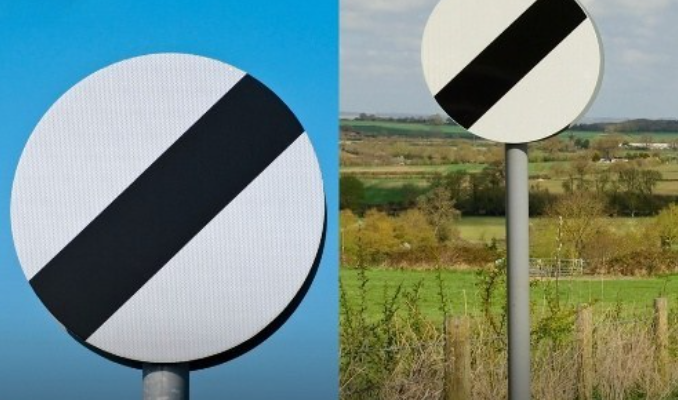The Mystery Behind the National Speed Limit Sign: A Hidden Driving Dilemma
A recent debate that ignited on social media revealed a fascinating insight into the often-overlooked confusion surrounding a seemingly simple yet critical road sign: the national speed limit sign. This particular sign, which is circular with a thick black diagonal stripe cutting across a white background, is a staple of roads across the United Kingdom. Yet, many motorists, despite passing their theory tests, fail to recognize or misinterpret the meaning behind it.
The motorist who sparked the online discussion claimed that “99% of drivers” don’t fully understand the significance of the national speed limit sign. Although this may be an exaggeration, there is a significant amount of truth in the claim. The fact that many drivers either misinterpret or forget the purpose of this sign after passing their driving tests highlights an unsettling gap between the knowledge gained during the learning process and real-world driving behavior.
The National Speed Limit Sign: A Brief Overview
In theory, the national speed limit sign is easy to understand. It indicates that the national speed limit applies from that point forward, overriding any previously imposed limits, such as those for temporary zones or areas with lower speed restrictions. However, its simplicity is deceiving. Despite its presence being mandated in driving theory tests, many drivers continue to misuse or misunderstand the sign’s purpose, particularly when they encounter it in real-world driving situations.
According to the Royal Automobile Club (RAC), the national speed limit is determined by the type of road and the category of the vehicle. On single carriageways, the limit for cars is 60 mph, while on dual carriageways and motorways, it increases to 70 mph. However, the limit is lower for certain vehicles, such as vans and vehicles towing trailers, which must adhere to a 50 mph limit on single carriageways and a 60 mph limit on dual carriageways and motorways. In built-up areas, where street lighting is frequent, the default speed limit remains 30 mph.
These variations, based on road type and vehicle category, explain why the national speed limit sign can be so confusing. While the sign is meant to signal a return to these standard limits, many drivers don’t fully understand that it doesn’t mean they should always go as fast as possible.
The Misinterpretation of the Sign
In a Reddit discussion surrounding the sign, users shared a variety of humorous (and sometimes absurd) guesses about its meaning. Suggestions like “national drifting zone” or “go as fast as you want” reflect how drivers often misread or misunderstand road signs when they are out on the road. This is particularly true when it comes to the national speed limit sign, which some drivers interpret as an invitation to speed or overtake without regard for road conditions, weather, or traffic.
This casual misinterpretation of the sign can lead to dangerous driving behaviors. In some cases, it can encourage drivers to accelerate recklessly without assessing the surrounding environment. While it’s clear that the sign doesn’t explicitly mean “drive as fast as you like,” the confusion surrounding it often leads drivers to take liberties with their speed, ignoring the fact that safety should always come before meeting a speed limit.
A Disconnect Between Theory and Practice
One of the key reasons behind this confusion is the gap between driving theory and practice. Many people pass their driving tests without ever really understanding how road signs and speed limits work in the context of real-world conditions. While drivers may be able to recite the rules during their theory test, they are often ill-prepared for the complexities of interpreting road signs when they are on the road.
Real-world driving is far more nuanced than the black-and-white rules that appear in textbooks. Conditions such as bad weather, heavy traffic, or poor road quality often demand more conservative speeds, even when the national speed limit is technically in place. This is where the disconnect arises: drivers may know the rules on paper but fail to adjust their behavior based on the actual conditions of the road they are driving on.
The Importance of Ongoing Road Education
This confusion over the national speed limit sign underscores the importance of continuous road education beyond the theory test. While passing the driving test may give a driver the ability to operate a vehicle legally, it doesn’t necessarily equip them with all the knowledge they need to drive safely and responsibly in various real-world scenarios.
In fact, many drivers may benefit from refresher courses or ongoing education about road signs and their practical implications. Some driving schools offer additional lessons, such as eco-driving courses or courses focused on motorway driving, that could help bridge this gap. Additionally, local authorities could consider introducing public awareness campaigns that focus on these often misunderstood road signs, helping to dispel myths and reinforce safe driving habits.
The Role of Discretion in Driving
The confusion surrounding the national speed limit sign also highlights the importance of discretion and common sense in driving. While road signs provide vital guidance, they are not a substitute for the driver’s judgment. As the RAC emphasizes, road safety should always take precedence over strictly adhering to the national speed limit.
For instance, in inclement weather, a driver may need to reduce their speed below the limit to maintain control of the vehicle. Similarly, during heavy traffic or on roads with many intersections, a lower speed may be necessary for the safety of all road users. This flexibility is a crucial aspect of safe driving, and it’s something that goes beyond what’s taught in driving tests.
Conclusion
In conclusion, while the national speed limit sign is clear in its legal meaning, it’s evident that many drivers misunderstand its purpose in practice. This confusion highlights a broader issue with road education and the gap between theory and actual driving behavior. To improve road safety, both drivers and authorities must recognize the importance of ongoing education and discretion. After all, a sign may tell you when to speed up, but it’s up to the driver to decide how fast is safe under the conditions they face.



